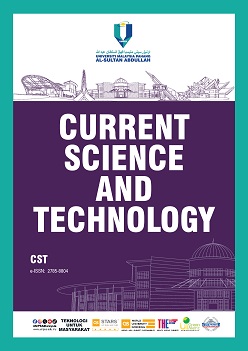Evolution of Graphene, Graphene Oxide, Reduced Graphene Oxide: An Exploratory Study Using Citation Network Analysis
DOI:
https://doi.org/10.15282/cst.v4i1.10294Keywords:
Graphene, Graphene oxide, Reduced graphene oxide, Citation Network Analysis, Main Path Analysis, ClustersAbstract
Graphene and its synthesis, along with its derivatives, have been at the forefront of materials’ research since its discovery in 2004. An analysis done during Dec 2023 using the keywords “graphene” and “synthesis” revealed nearly 40,000 research papers including journal articles, conference proceedings, reviews, books and book chapters; analysis of this vast data is beyond human abilities and requires computational intelligence. One of the research methodologies employed in analysing such vast data is Citation Network Analysis (CNA). Choosing the threshold citation to be two, the CNA constituted a cluster containing 294,680 papers. Using CNA, this study categorises this extensive literature into 12 clusters, unveiling their main paths of evolution. Notably, the most active research area focuses on the development of electrode materials for electrochemical applications. Additional focal points include advanced photocatalysts, electrocatalytic nitrogen fixation, wideband electromagnetic wave absorption materials, catalysts for formic acid oxidation, and flame retardancy in epoxy resin. The preference for the modified Hummers' method for synthesising graphene oxide emerges prominently due to its scalability. The implications of these findings are profound, paving the way for advancements in graphene synthesis with widespread impacts in industrial applications. By examining the historical trajectory of graphene research, this study offers critical insights, guiding future research endeavours in advanced materials science
References
[1] G. Ruess and F. Vogt, “Hoechstlamellarer Kohlenstoff aus Graphitoxyhydroxyd,” Monatshefte Für Chemie - Chemical Monthly, vol. 78, no. 3–4, pp. 222–242, 1948.
[2] H. P. Boehm, R. Setton, and E. Stumpp, “Nomenclature and terminology of graphite intercalation compounds,” Carbon, vol. 24, no. 2, pp. 241–245, 1986.
[3] K. Seibert, G. C. Cho, W. Kütt, H. Kurz, D. H. Reitze, J. I. Dadap et al., “Femtosecond carrier dynamics in graphite,” Physical Review, vol. 42, no. 5, pp. 2842–2851, 1990.
[4] T. W. Ebbesen and H. Hiura, “Graphene in 3-dimensions: Towards graphite origami,” Advanced Materials, vol. 7, no. 6, pp. 582–586, 1995.
[5] X. Lu, M. Yu, H. Huang, and R. S. Ruoff, “Tailoring graphite with the goal of achieving single sheets,” Nanotechnology, vol. 10, no. 3, pp. 269–272, 1999.
[6] A. K. Geǐm, “Graphene prehistory,” Physica Scripta, vol. T146, p. 014003, 2012.
[7] A. A. Moosa and M. S. Abed, “Graphene preparation and graphite exfoliation,” Turkish Journal of Chemistry, vol. 45, no. 3, pp. 493–519, 2021.
[8] H. Lee, J. I. Choi, J. Park, S. S. Jang, and S. W. Lee, “Role of anions on electrochemical exfoliation of graphite into graphene in aqueous acids,” Carbon, vol. 167, pp. 816–825, 2020.
[9] G. Liu, Z. Xiong, L. Yang, H. Shi, D. Fang, M. Wang et al., “Electrochemical approach toward reduced graphene oxide-based electrodes for environmental applications: A review,” Science of the Total Environment, vol. 778, p. 146301, 2021.
[10] A. D. Pingale, A. Owhal, A. S. Katarkar, S. U. Belgamwar, and J. S. Rathore, “Facile synthesis of graphene by ultrasonic-assisted electrochemical exfoliation of graphite,” Materials Today: Proceedings, vol. 44, pp. 467–472, 2021.
[11] W. S. Hummers and R. E. Offeman, “Preparation of graphitic oxide,” Journal of the American Chemical Society, vol. 80, no. 6, p. 1339, 1958.
[12] M. H. A. Kudus, M. R. Zakaria, H. M. Akil, F. Ullah, and F. Javed, “Oxidation of graphene via a simplified Hummers’ method for graphene-diamine colloid production,” Journal of King Saud University - Science, vol. 32, no. 1, pp. 910–913, 2020.
[13] A. Alkhouzaam, H. Qiblawey, M. Khraisheh, M. A. Atieh, and M. A. Al-Ghouti, “Synthesis of graphene oxides particle of high oxidation degree using a modified Hummers method,” Ceramics International, vol. 46, no. 15, pp. 23997–24007, 2020.
[14] Y. Zhu, G. Kong, Y. Pan, L. Liu, B. Yang, S. Zhang et al., “An improved Hummers method to synthesize graphene oxide using much less concentrated sulfuric acid,” Chinese Chemical Letters, vol. 33, no. 10, pp. 4541–4544, 2022.
[15] R. Muszynski, B. Seger, and P. V. Kamat, “Decorating Graphene Sheets with Gold Nanoparticles,” The Journal of Physical Chemistry C, vol. 112, no. 14, pp. 5263–5266, 2008.
[16] M. Pumera, “Graphene-based nanomaterials and their electrochemistry,” Chemical Society Reviews, vol. 39, no. 11, p. 4146, 2010.
[17] Z. Luo, N. J. Pinto, Y. Davila, and A. T. C. Johnson, “Controlled doping of graphene using ultraviolet irradiation,” Applied Physics Letters, vol. 100, no. 25, p. 253108, 2012.
[18] C. Yang, C. Huang, and J. Su, “An improved SAO network-based method for technology trend analysis: A case study of graphene,” Journal of Informetrics, vol. 12, no. 1, pp. 271–286, 2018.
[19] A. L. Nguyen, W. Liu, K. A. Khor, А. Нанетти, and S. A. Cheong, “The emergence of graphene research topics through interactions within and beyond,” Quantitative Science Studies, vol. 3, no. 2, pp. 457–484, 2022.
Downloads
Published
Issue
Section
License
Copyright (c) 2024 The Author(s)

This work is licensed under a Creative Commons Attribution-NonCommercial 4.0 International License.



